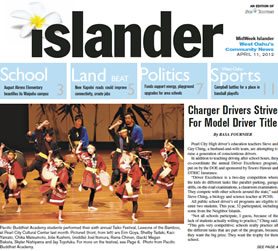Charger Drivers Strive For Model Driver Title
Pearl City High driver’s education teachers Steve and Gay Ching, a husband-and-wife team, are attempting to raise a generation of conscientious drivers.
In addition to teaching driving after school hours, they co-coordinate the annual Driver Excellence program, put on by the DOE and sponsored by Tesoro Hawaii and DTRIC Insurance.
Ryan and Jessica Higashi
“Driver Excellence is a two-day competition where the kids do different tasks like parallel parking, garage drills, on-the-road examinations, a classroom examination. They compete with other schools around the state,” said Steve Ching, a biology and science teacher at PCHS.
All public school driver’s ed programs are eligible to enter two students. This year, 32 participated, including some from the Neighbor Islands.
“Not all schools participate, I guess, because of the lack of students actually willing to practice,” Ching said. “This gets very competitive; schools really practice all the different tasks that are part of the program, because they want the big prize. They want the trophy for their school.
“We try to be competitive, but the Big Island and Maui are very competitive and they usually win first place. We took second last year. This year we weren’t so fortunate.” (A Maui school won.)
This year’s PCHS student competitors were Jessica Higashi and Reece Teramoto. The first day of the March 23-24 event at Aloha Stadium consisted of students showing off their best driving skills.
The second day included family involvement and a Distracted Driving component with Higashi and Teramoto partnering with their parents, Ryan and Dana, respectively.
“It’s a family fun day where the student may bring in their parent and they compete with other students and parents from other schools,” Ching said. “They do a precision reverse drill where they have to reverse at angles and make a Z, going backwards without hitting any cones. The more cones they hit, the more points are deducted. If you don’t hit any cones, you get a perfect score.
“With the distracted driving, parents and students have about 200 yards where they go through different obstacles, and we give them a distraction method.”
The distraction is meant to replicate real-life distractions, so it may include using a cell phone while driving or an assortment of other distractions. Unique components introduced this year were “fatal vision” and “concussion” goggles, which imitate the experience of driving under the influence or while experiencing a concussion after a crash.
The Chings’ goal is to change up the competition each year by adding something new. Next year they plan to continue with the distracted-driving theme, but with a novel focus. Their inspiration will come from a Mainland driving program called SWERVE, which initiated the concept of teaching students about distracted driving.
The program has a team of instructors who go from state to state bringing their concepts to driver’s ed programs to drive home what constitutes distracted driving and how dangerous it is.
The Chings first introduced the program to Hawaii about five years ago, and they’re excited to be bringing SWERVE instructors here again this week to teach a core group of DOE members and teachers what will be incorporated into next year’s driving competition.
“For some who participate in the Driver Excellence program, they get a real eye-opener,” Ching said. “Most of them in driver’s ed (drive safely, but when you add distractions), they’re all over the road.
“It’s a controlled environment at the stadium: They’re not out on the road, so when they hit a couple cones, we tell them, ‘You could have hit someone on the sidewalk or in a crosswalk.’
“They get the message through that medium, that it could have been something or somebody that they hit.”







